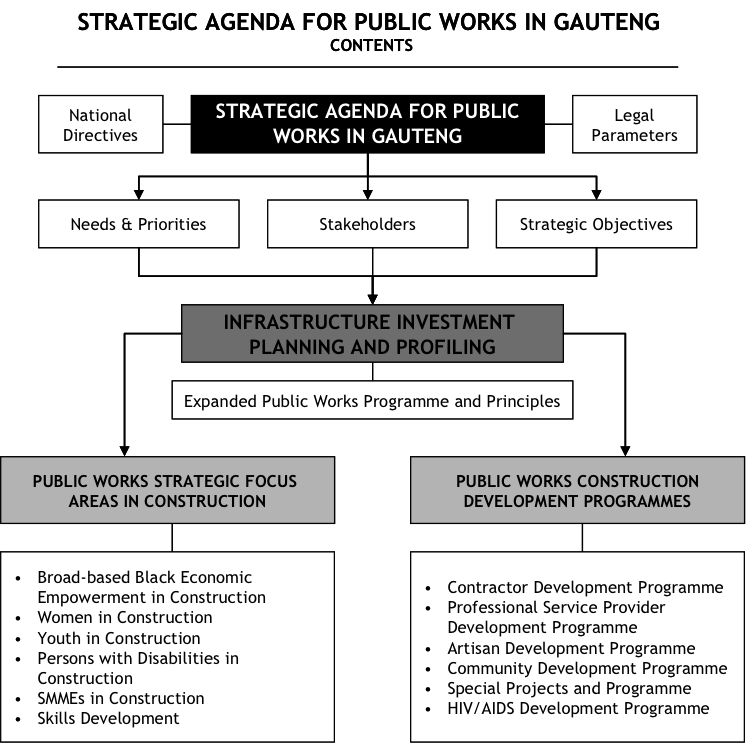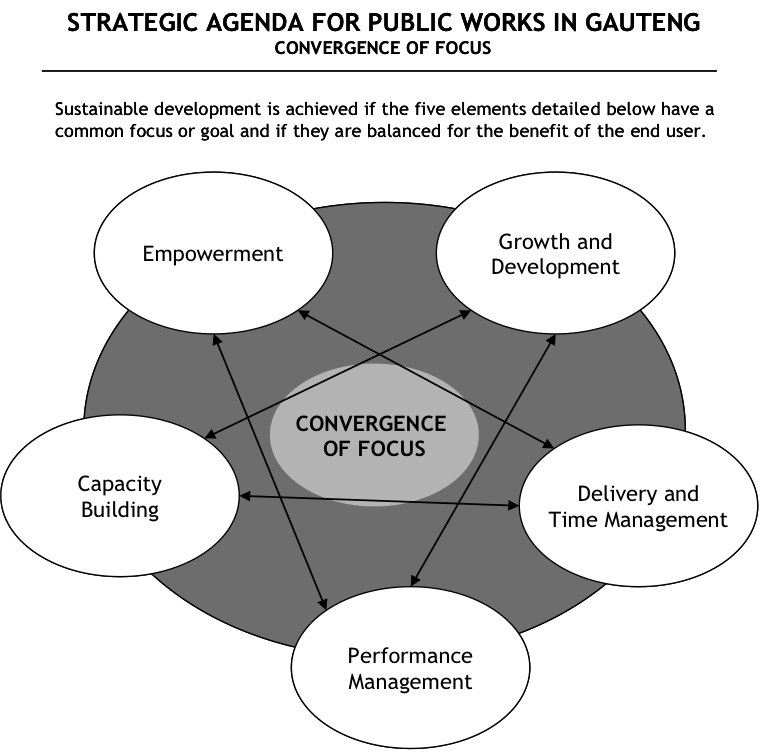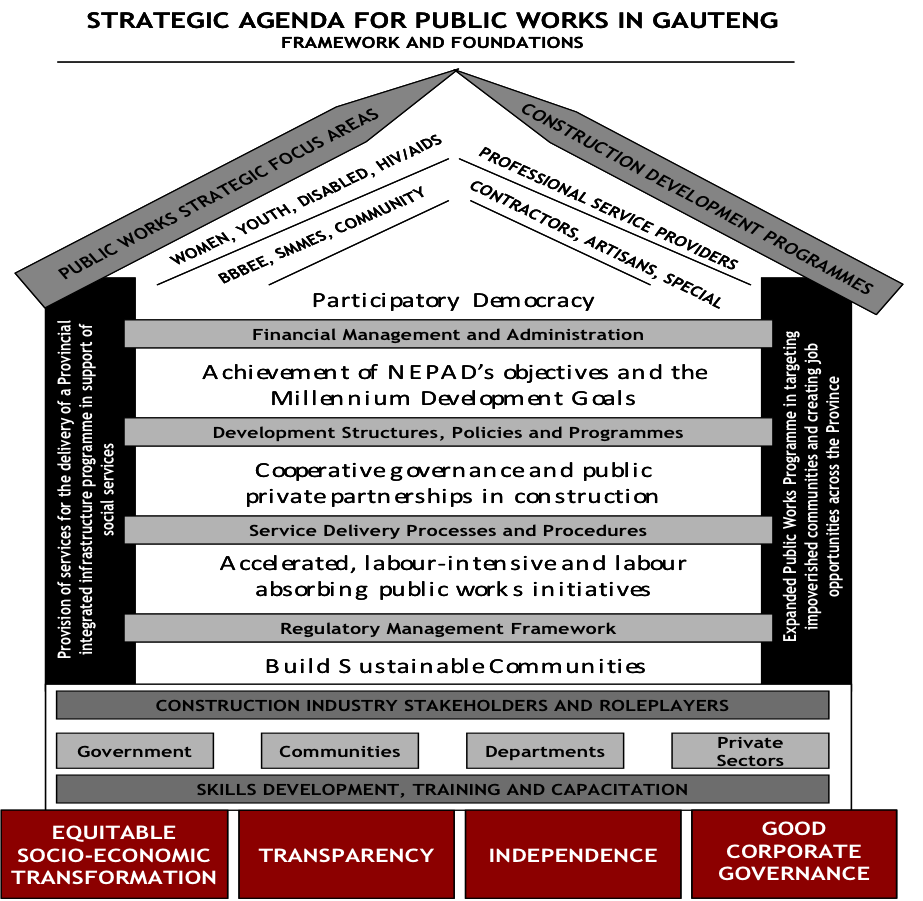Strategic agenda for public works
Between 2000 and 2008 the South African economy was growing, but it did not generate sufficient employment to meet the growing population of work seekers. A government’s commitment to infrastructure investment signals a period of growth for the construction industry. Improving macro-economic stability and increasing finances will provide government with greater ability to realise this intention, which is reinforced by the urgent need:
- To meet the built environment needs for development of a whole society;
- To ensure that the construction industry (in its broadest definition) offers access into the mainstream economy for those sectors of society disadvantaged by the policies of apartheid and the forces of colonialism; and
- To create a competitive construction industry that meets global standards of performance in terms of quality, productivity, safety, health and the environment.
Emerging social trends such as reduced household sizes and changing migration patterns signify the growing provision of infrastructure in towns and urban areas. These trends also highlight the requirement for a constant review and redefinition of the concept of infrastructure “backlogs” which will match the expanding the economy.
Embodied in policy and legislation is the recognition that our developing society inherited a construction sector that supports a well-developed industry with world-class capability, as well as a functioning material-manufacturing sector. The post-1994 expansion of South African engineering and construction services into global markets is testament to this inherent capability, and was enabled by the country’s passage to democracy. At the same time, the post-1994 policy framework reflects the imperative to transform the racial ownership and participation profile of the construction industry.
However, the decline in infrastructure investment during apartheid has left imbalances, and these need to be addressed by consolidating the lessons learnt from the past. This has been done through dedicated artisan programmes and a focused drive to empower smaller, emerging contractors in the province.
Credit and cash flow management are critical components of modern financial practice and competitiveness in the construction industry. With a commitment to best payment practices both government and industry can achieve much higher levels of performance, thereby creating a positive and enabling environment for sustainable development. The threat of non-payment or delayed payment results in unnecessary provisions and expenses incurred by the contractor. This can further generate an extremely negative downward spiral for contract work negotiations. Small and emerging enterprises are the most vulnerable to cash flow difficulties and benefit most from sound payment practices.
Public works strategic agenda components
Public works focuses on the efficient delivery of and investment into public infrastructure for the benefit of the greater good and the improvement of the quality of life for those accessing the infrastructure. The components of the Strategic Agenda for Public Works in Gauteng sought to break down the action requirements and focus the implementation process for the coming 5-10 years. The Strategic Agenda for Public Works set the basis for what was to be the Public Works Charter, and was premised on major components (namely, the Public Works Strategy Focus Areas and Construction Development Programmes).

The Strategic Focus Areas in construction include:
- Black Economic Empowerment (BEE) in construction;
- Women in construction;
- Youth in construction;
- People with disabilities in construction;
- SMMEs in construction;
- HIV/AIDS in construction; and
- Skills development.
The construction development programmes include:
- A contractor development programme;
- A professional service provider development programme;
- An artisan development programme;
- A community development programme; and
- Special projects and programmes.
The two components (strategic focus areas and construction development programmes) were grounded on the principles of the Expanded Public WorksProgramme (EPWP). The EPWP was not a sectoral initiative, but rather an all-encompassing initiative that embodied the principles of the Millennium Development Goals and general governance. Community needs essentially influenced, and therefore directed, the type of project to be implemented. The aim of government within the context of construction and development was to ensure that the identified needs are integrated and strategically delivered in order to best achieve the desired product with the limited resources available.
Expanded Public Works Programme contextualised
The then-president, Thabo Mbeki, formally announced the Expanded Public Works Programme (EPWP) in his State of the Nation address in February 2003, and Cabinet adopted it in November 2003. The EPWP was one part of an overall government strategy to reduce poverty through the alleviation and reduction of unemployment. The EPWP was conceived as a short-to-medium-term programme that would provide work opportunities coupled with training. It was a national programme covering all spheres of government and state-owned enterprises. The programme involved reorienting line function budgets and conditional grants so that government expenditure resulted in more work opportunities, particularly for unskilled labour.
The legacy of the past has meant a large proportion of South Africa’s population does not yet have the skills or opportunities to effectively participate in the economy. The EPWP was one of government’s initiatives to try to bridge the gap between the growing economy and the large numbers of unskilled and unemployed people who have not yet enjoyed the benefits of economic development. The EPWP encouraged the creation of temporary work and training opportunities for the unemployed, using public sector expenditure.
It built on existing best-practice government infrastructure and social programmes that are known to be successful, by either deepening their labour absorption or extending them. Opportunities for implementing the EPWP had been identified in the environmental, social and economic sectors. The programme was focused on unemployed, under-skilled and under-qualified persons and aimed to provide opportunities:
- To draw significant numbers of the unemployed into productive work, enabling them to earn an income;
- To provide unemployed people with skills training;
- To ensure those participants in the EPWP are able to set up their own business or become employed on a more permanent basis; and
- To utilise public sector budgets to reduce and alleviate unemployment.

A construction business requires very limited permanent capital to start operations. Construction projects are largely financed through interim or monthly payments that fund the next stage or period of work, which is an ideal environment for investment. Capital requirements are restricted to the spread in cash flow between payments and receipts. Furthermore, many types of construction require nominal levels of technology. The overall result is that construction is a business with very low barriers on entry. On this basis, the industry represents a major opportunity for empowerment of previously disadvantaged individuals. An enabling environment where this transformation can occur needs to be cultivated through government intervention, credit, strategic management, early payment systems and a constant supply of work. The construction sector, which consists of different disciplines with a proliferated client and supplier base, performs an indispensable role in the economy of South Africa and increasingly of the SADC region as a whole.

The development framework sees the convergence of stakeholder focus for sustainable service delivery, growth and empowerment, on the one hand, and the improving capability and performance of the construction industry on the other. Growth is about increased enterprise investment in infrastructure and enterprise growth. Delivery looks at improved performance in the planning, procurement, delivery and maintenance of infrastructure. Performance considers continuous improvement in aspects of the industry such as processes, quality, people, employment, health and safety, the environment, and productivity. Capacity looks at satisfying the demand for skilled people and resources to face challenges and make use of opportunities presented to the industry. Empowerment is linked to transformation within all areas and sectors of the industry so as to meet aspirations, including skills transfer projects, joint ventures and partnerships.